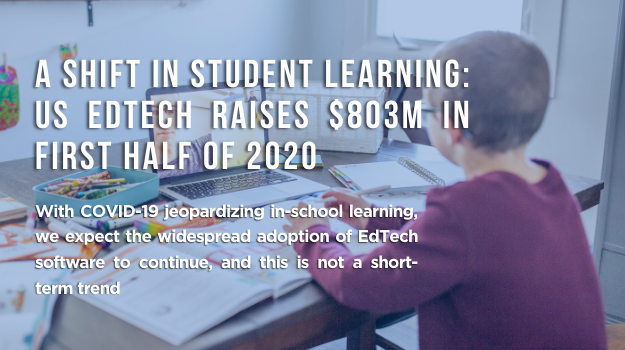
Most classroom doors have been locked. But the investor checkbooks remain free.
Although the pandemic has affected education even more than any fad in Silicon Valley, it has also intensified the sort of technologies that the industry has long been willing to embrace. When people are pressured to study from home, some online education programs are more in demand than ever. And that’s what private companies have taken up.
“With COVID-19 jeopardizing in-school learning, we expect the widespread adoption of EdTech software to continue, and this is not a short-term trend,” says Jeff Lieberman, a managing director at Insight Partners. This private equity firm has backed nearly two dozen education companies. “Software will reshape learning both in the classroom and out well beyond the pandemic.”

In the first half of 2020, U.S. education technology firms raised more than $803 million in venture capital, according to the EdSurge index of publicly disclosed financing agreements.
That number is a 17% dip from the $962 million we tracked for the first six months of 2019 (which ended up being a record year for U.S. EdTech venture capital), but the 2020 figure is also in line with the first half of the overall funding for the previous five years.
U.S. EdTech investment dynamics largely reflect patterns in other markets. Crunchbase data revealed that the first half of global venture funding fell by 7% to $129 billion from the same duration in 2019.
Pitchbook reported a similar trend, adding that the pandemic’s effect on overall V.C. activity was not apocalyptic, with healthcare, digital industry, and consumer-service startups raising a lot of money.
The $803 million has been invested in 61 publicly disclosed transactions. While this statistic is generally consistent with the number of acquisitions made over the last five years, according to education investors, the number of inbound funding prospects for venture firms has risen.
Funders who have rarely looked at the education sector in the past have now been pulled into the industry. “COVID has been an accelerant to all of the trends—increase in digitization, skills-based training—that were already there,” says Maia Sharpley, a partner at Learn Capital. “It makes investors who were not previously interested in the market come in.”

Topping the lists of the highest U.S. EdTech investment rounds is a trio of consumer-oriented companies. In February, Roblox, an online gaming site where people make, upload and sell games, raised $150 million.
Although the organization works mainly in the entertainment field, it has an academic staff of instructional designers who teach children how to program. It collaborates with more than 100 educational coding camps and programs worldwide that Roblox provides through its curriculum.
Udemy, which has earned $50 million, provides a marketplace of more than 100,000 courses covering everything from industry to technology to personal growth.
Of the ten highest publicly disclosed grant agreements, only two have a business plan focused on marketing to K-12 colleges. Yet, the pandemic took them in various directions. PresenceLearning, which offers online teletherapy sessions to assist students with special needs, raised $27 million in May, and said demand for its programs has risen.
The other, HopSkipDrive, raised $22 million in February but was forced to lay off its school ride-sharing program following campus closures.
Other startups with an emphasis on K-12 revenues were forced to change to survive. Swing Education, which typically pairs teachers with school work vacancies, has redirected its service to capitalize on the new “learning pods” movement. Families set up their own informal, private education groups.
Most districts in K-12 are prepared for funding cuts due to declining taxes from their local communities, which have had an effect on sales procurement times and how much they can spend on programs such as technology.
However, not all startups are affected similarly. Many that help fill the contact divide and have high-quality teaching materials would be better off, says Sharpley.
With less public dollars for EdTech programs, can private funders and customers fill the gap?
